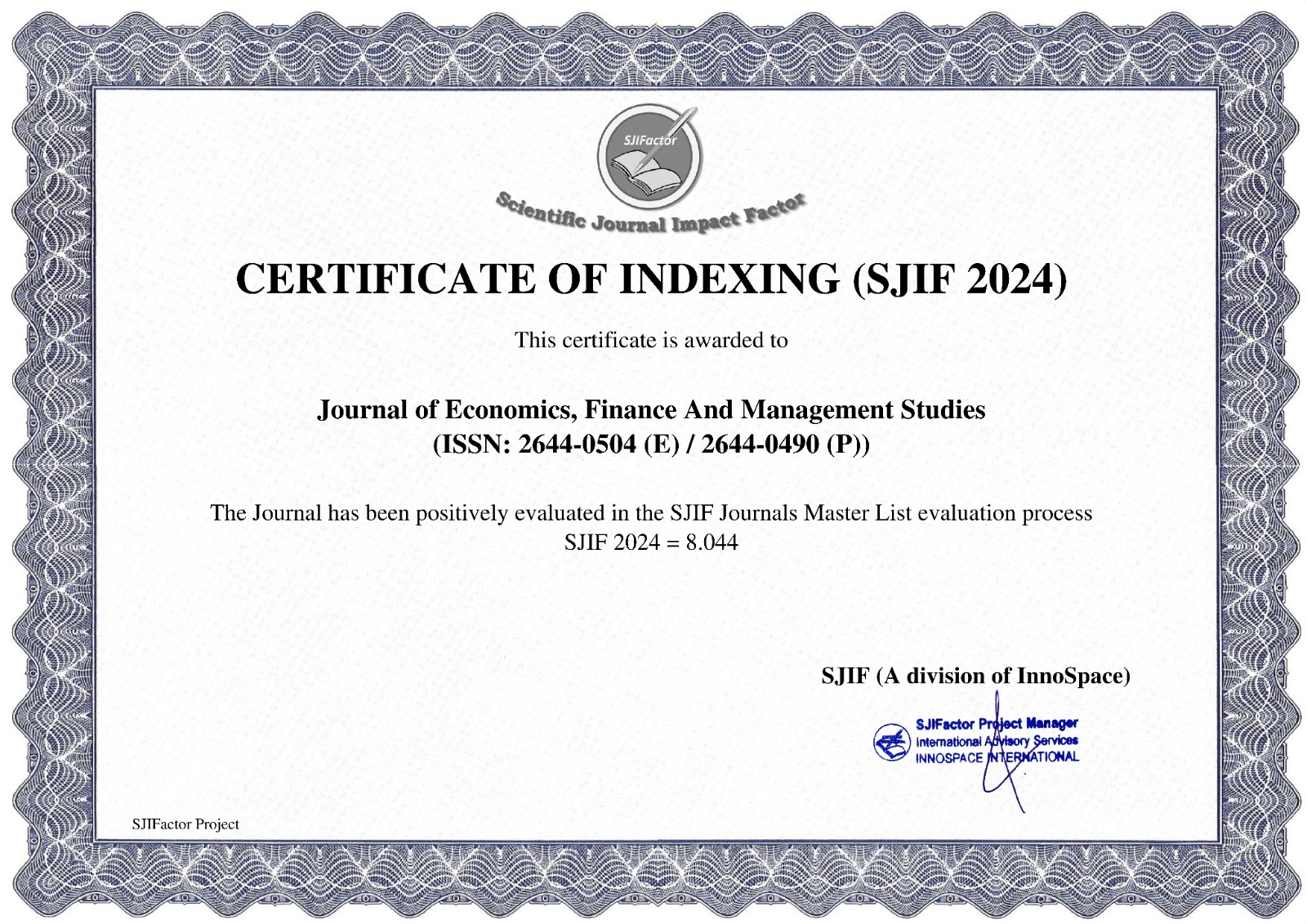Transactional Leadership Style and Employee Performance in Selected Non-Governmental Organizations in Uganda
4Muguluma Henry, 1,3Olutayo K. Osunsan, 2Alinitwe Joshua, 1,2Naiga Sylvia, 1,4Tindimwebwa Joseline, 2Namirembe Isabella
1School of Postgraduate Studies & Research, Africa Renewal University, Uganda
2School of Business Management and IT, Africa Renewal University, Uganda
3Faculty of Business and Management, Cavendish University Uganda
4School of social sciences and Humanities, Africa Renewal University, Uganda
https://doi.org/10.47191/jefms/v8-i3-06
ABSTRACT:
This study set out to determine the relationship between leadership style and employee performance in selected non-governmental organizations in Uganda. The leadership styles focused on were: transactional leadership and employee performance. A survey was conducted by administering questionnaires to 367 employees (respondents) in selected non-governmental organizations in Kampala. Overall, the results showed a weak positive and significant association between transactional leadership style and employee performance. In other words, the odds of an employee being satisfied were higher if they were led by a transactional leader. The findings showed that transactional leadership style is weakly associated with employee performance and that it would in the long run lead to a significant negative impact on employee performance. In a nutshell, the study found out that there is a small but sure relationship between transactional leadership style, and employee performance in nongovernmental organizations in Uganda.
KEYWORDS:
Transactional leadership Styles, and employee performance.
REFERENCES:
1) Afolabi, O., Obude, O.,Okediji, A., & Ezeh, L. (2008). Influence Of Gender And Leadership Style On Career Commitment And Job Performance Of Subordinates. Global Journal of Humanities, 7(1&2), 1-8.
2) Africa Renewal Ministries, (2013). Annual Program Report of 2012. Annual Performance Review, (pp. 15-17), Kampala.
3) Africa Renewal Ministries, (2013). Internal Audit Report of 2012. Annual Performance Review, (pp.18-20), Kampala.
4) Allen, W.R., Drevs, R.A. & Ruhe, J.A. (1999). Reasons why college-educated women change employment. Journal of Business and Psychology, Vol 14, No 1, P 77-93
5) Bass, B. M., Avolio, B. J., Jung, D. I., & Berson, Y. (2003). Predicting Unit Performance by Assessing Transformational and Transactional Leadership. Journal of Applied Psychology, 88(2), 207.
6) Bennett, T., (2009). “The relationship between the subordinate’s perception of the leadership style of it managers and the subordinate’s perceptions of manager’s ability to inspire extra effort, to be effective, and to enhance satisfaction with management”, Proceedings of the Academy of Strategic Management, Vol. 8, No.1.
7) Burns, J.M.G. (1979). Two Excerpts from" Leadership.". Educational Leadership, Vol 36, No 6, P 380-83
8) Epitropaki, O. and Martin, T., (2005). “The moderating role of individual differences in the relation between transformational/transactional leadership perceptions and organizational identification, Leadership Quarterly Journal, Vol. 16, No. 4, pp.569-589.
9) Erkutlu, H.V. & Chafra, J. (2006). Relationship between leadership power bases and job stress of subordinates: example from boutique hotels. Management Research News, 29(5): 285-297.
10) Field, A. (2006). 'Factor analysis using SPSS. 'Retrieved from http://www.sussex.ac.uk/users/andyF/factor.pdf
11) Gadot, E. V. (2007). Leadership style, organizational politics, and employees’ performance.Leadership Style, 36(5), 661-683.
12) Hair, J., Black, B., Babin, B., Anderson, R., & Tathan, R. (2006) Multivariate Data Analysis, 6th ed., New York: Prentice Hall.
13) Janssen, O., & Yperen, N. W. (2004). Employees’ goal orientations, the quality of Leader-member exchange, and the outcomes of job Performance and job satisfaction. Academy of Management Journal, 47(3) , 368–384.
14) Jung, D., Yammarino, F., and Lee, J., (2009). “Moderating role of subordinates’ attitudes on transformational leadership and effectiveness: A multi-cultural and multi-level perspective”, The Leadership Quarterly, Vol. 20, pp.586-603.
15) Krejcie, R.V., and Morgan, D.W. (1970). Determining sample size for research activities, Educational and Psychological Measurement 30(3), 607-610.
16) Mukasa, S. (2006) “Are expatriate staff necessary in international development NGOs? A case study of an international NGO in Uganda”, CVO International Working Paper 4, http://www.lse.ac.uk/collections/CCS/pdf/int-work-paper4.pdf (Accessed, November 11 2013)
17) Rad, A.M.M. & Yarmohammadian, M.H. (2006). A study of relationship between managers’ leadership style and employees’ job satisfaction. Leadership in Health Service, 19(2): 11- 28.
18) Wu, F., (2009). “The Relationship between leadership styles and foreign English teachers job satisfaction in adult English cram schools: Evidences in Taiwan”, The Journal of American Academy of Business, Cambridge, Vol. 14, No.2.
19) Yavirach, Natepanna, (2012). The Impact of Transformational and Transactional Leadership to Subordinates' Job Satisfaction, Organizational Commitment Affect to Team Effectiveness. Available at SSRN: http://ssrn.com/abstract=2159035 or http://dx.doi.org/10.2139/ssrn.2159035(Accessed on 25.06.2014)
20) Yurchisin, J. & Park, J. (2010). Effects of Retail Store Image Attractiveness and Self-Evaluated Job Performance on Employee Retention. Journal of Business and Psychology, Vol 25, No 3, P 441-450
















